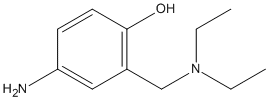ADOC
General
Type : non-oxime
Chemical_Nomenclature : 4-amino-2-(diethylaminomethyl)phenol
Canonical SMILES : CCN(CC)CC1=C(C=CC(=C1)N)O
InChI : InChI=1S\/C11H18N2O\/c1-3-13(4-2)8-9-7-10(12)5-6-11(9)14\/h5-7,14H,3-4,8,12H2,1-2H3
InChIKey : KRQUHMFZMVSALZ-UHFFFAOYSA-N
Other name(s) : 4-Amino-2-[(Diethylamino)Methyl]Phenol, Phenol, 4-amino-2-[(diethylamino)methyl]-, 4-amino-alpha-diethylamino-O-cresol, 4-amino-2-((diethylamino)methyl)phenol, AC1L9Z3H, SCHEMBL1998660, NSC17568, NSC-17568, NSC108348, AC1OCJPP, ZB001649
MW : 194.27
Formula : C11H18N2O
CAS_number : 51387-92-9 || 6297-14-9
CID PubChem :
InChIKey UniChem :
Iuphar :
Wikipedia :

Target
Structure : No structure
Families : No family
References
No reference